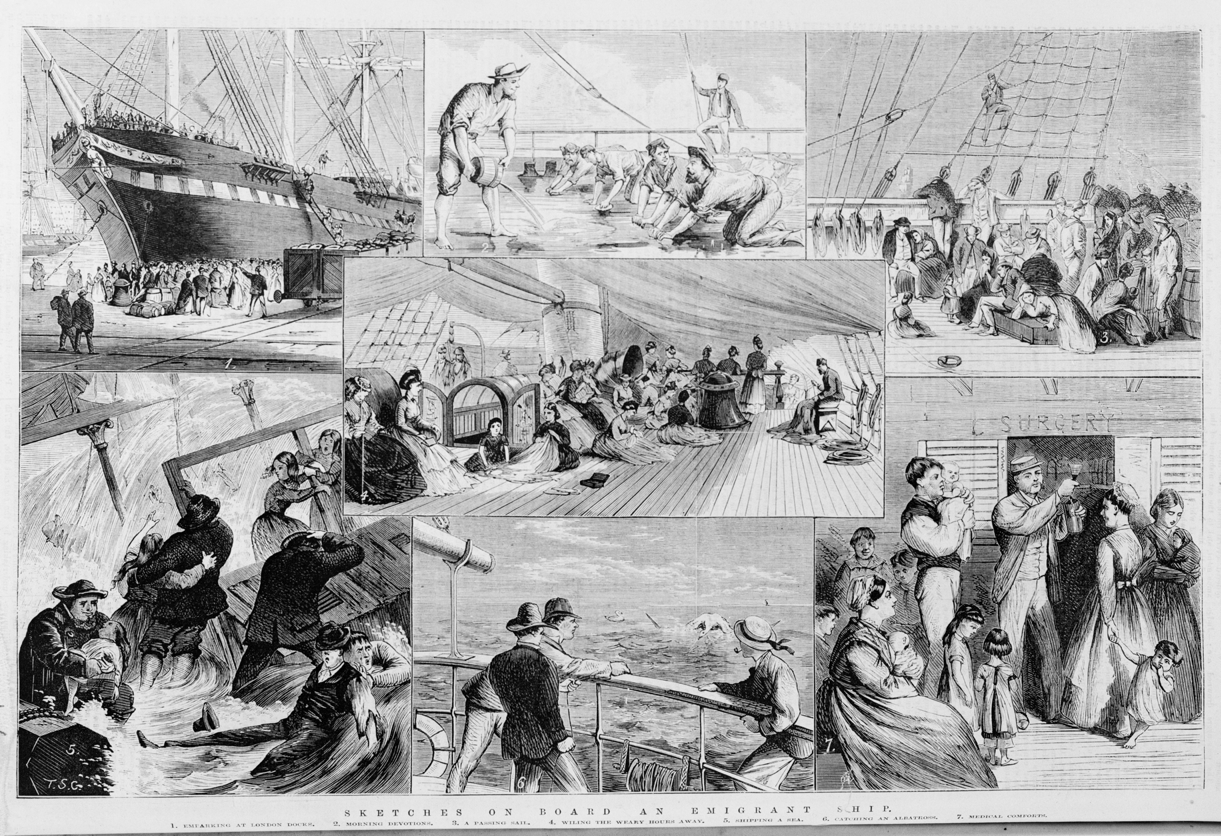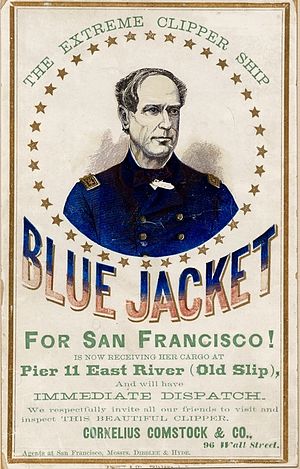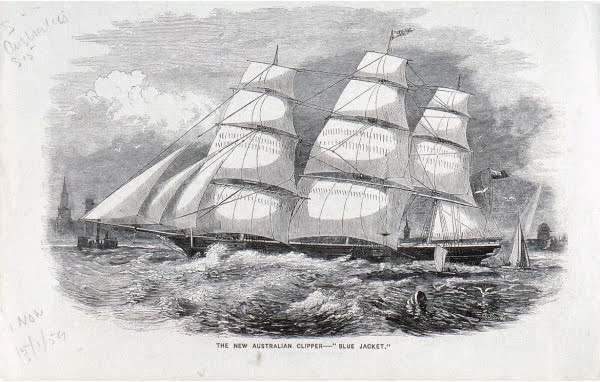|
 (Src. Sydney Morning Herald 26 May 1855): The Clipper Ship Blue
Jacket: :: She is a ship designed to stow
 a large cargo
and sail fast. She has rounded lines with sharp ends, a long floor, and an
easy, graceful sheer, with just rise enough at the ends to impart buoyancy
and boldness to her general outline. Her length on the keel is 205 feet,
between perpendiculars on deck 228, and over all, from the knight-head- to
the taffrail, 285. Her extreme breadth of beam is 41 feet 2 inches, depth
of hold 24 feet, including 8 feet height of between decks, and she has a
full topgallant fore-castle, a large house abaft the foremast, and full
poop deck. Her bow is long and sharp, has a bold and dashy forerake,
flares as it rises, and is ornamented with the full figure of a sailor,
with a flag half displayed in his left hand, and a cutlass in his right,
the whole relieved with gilded carved work, descending aft from the
pedestal. Her stern is light and rounded, and is ornamented with an arch
of gilded carved work with representations of fruits and flowers in its
centre. The run in long and clean; and broadside on, the ship looks
exceedingly well, having been finished with great care, in the best style
of workmanship. a large cargo
and sail fast. She has rounded lines with sharp ends, a long floor, and an
easy, graceful sheer, with just rise enough at the ends to impart buoyancy
and boldness to her general outline. Her length on the keel is 205 feet,
between perpendiculars on deck 228, and over all, from the knight-head- to
the taffrail, 285. Her extreme breadth of beam is 41 feet 2 inches, depth
of hold 24 feet, including 8 feet height of between decks, and she has a
full topgallant fore-castle, a large house abaft the foremast, and full
poop deck. Her bow is long and sharp, has a bold and dashy forerake,
flares as it rises, and is ornamented with the full figure of a sailor,
with a flag half displayed in his left hand, and a cutlass in his right,
the whole relieved with gilded carved work, descending aft from the
pedestal. Her stern is light and rounded, and is ornamented with an arch
of gilded carved work with representations of fruits and flowers in its
centre. The run in long and clean; and broadside on, the ship looks
exceedingly well, having been finished with great care, in the best style
of workmanship. The whole height of her bulwarks, including a monkey rail 2 feet 4 inches, is 6 feet 4 inches, and they are well supported by oak stanchions. In the wake of the poop and topgallant forecastle, she is built solid and closely fastened. Her poop deck is 80 feet long by 7 high, with a projecting front, which protects the entrance to the anteroom of the saloon, and a staircase amidships, which leads to the deck below. The saloon is 40 feet long by 14 wide, is beautifully wainscoated, and ornamented with gilded flower-work and branches on the panels, set off with papier-mache cornices; and its ground work is pure white, equalling enamel in its smoothness and brilliancy. It contains twelve spacious state- rooms, each room having a square in its side and deck lights above, and is furnished in the most convenient style for the accommodation of passengers. In the centre of the saloon is a walnut table, extending its whole length, with rich settees on each side, and the floor or deck is richly carpeted. Its ends are also ornamented with plate glass mirrors, which reflect the whole in the happiest style. The after, or ladies' cabin Is 30 feet long by 13 wide, and contains eight state-rooms and other apartments, including a bath-room, and is wainscotted with mahogany, the panels of which are ornamented with flowers in their natural hues, surrounded with delicate scrollwork of gold. The entablaturer are of rosewood, and their pillars of satinwood, with neatly carved capitals and pedestals, the whole relieved with papier mache cornices and gilded flowers along the corners of the beams. The ceiling of the cabin and saloon is pure white. A square mirror ornaments the forward partition and reflects the cabin abaft it, and a richly covered sofa fills the curve of the stern aft. Its furniture, and that of the state-rooms is of the most beautiful material, made in the highest style of marine art. The ladies' cabin has four stern windows and a large oblong square skylight, and two other skylights are over the saloon, one forward which lights and ventilates the entrance to the deck below. The anteroom contains the pantry on the larboard side, and a spacious state-room on the other side, both clear of the saloon. Mahogany stairs, inlaid and protected with brass, lead to the poop on each side, and the gangway boards and skylight frames are also of polished mahogany. The house abaft the foremast is 45 foot long by 18 wide, and
6 1/4? high, with skylight ventilators along its sides, and it contains
the galley, several store-rooms and state-rooms, and protects staircases
which lead to the deck below; and all the entranc The ship herself is of the best materials, and has been built with more than usual care. Her frame, all the knees in the hold, and all the hooks and pointers are of seasoned white oak, her ceiling and planking of hard pine, and she in butt and bilge-bolted with copper, and square fastened throughout. Her keel is of rock maple in two depths, with scarphs 12? feet long, sided sixteen inches, and moulded 30; the floor timbers are 18 by 14 on the keel and she has three depths of midship kelsons, each depth 16 inches square, and sister kelsons, which are also 16 inches square, the whole fastened with 1? inch copper and iron, the copper driven through, and clinched on the outside. The floor ceiling is five inches thick, bilge keel irons 16 inches square, and then com mencing outside of them, and extending over the bilge, there are five strates, of 12 by 14 inches, and the rest of the ceiling up to the lower deck, is 10 by 7 inches. All the thickwork is scarphed and bolted edgeways, as well as square fastened through the timbers. The lower deck beams are 16 by 14, and those under the upper deck 19? by 14 amidships, but tapered towards the ends. The between decks waterways are 16 inches square, and strike of 10 by 1?? inches inside of them, and 2 of the same size over them, the whole bolted vertically and horizontally, and the ceil- ing above is 6? inches think. Her upperdeck waterways are 13 inches square, with 2 thick strakes inside of them let over the beams, and the plunking of both decks is 3? inches thick, the upper deck of white, and the lower one of yellow pine. Her garboards are 7 by 14 inches, the next strake 6 inches thick, graduated to 4? inches, the thickness of the bottom planking, and the wales are 5(?) by 7, carried up flush, without projection to the covering board, which is 6(?) inches thick by 15 wide. In the hold she has four massive hooks and pointers forward, and three aft, which cross all the cants diagonally, and two of them extend to the deck. The hanging and lodging knees connected with the lower dock beams are of oak, the former sided 12 inches, and moulded 22 inches in the throats, with 28 bolts in each, and the latter are sided 10 inches, and scarphed together in every berth. Under the hanging knees there is a lap strake or stringer 5 inches thick, square bolted through all, and the stanchions are 10 x14 inches kneed above and below in the wake of the hatchway, and are elsewhere clasped with iron to the beams and the keelson, and bolted through them. The hanging and lodging knees in the between decks are of hacmatack, and are nearly of the same size as those below, and have 24 bolts in each; and the ceiling, between the hanging knees, is diagonally cross-braced with hard pine and bolted through all. The midship stanchions are of oak, turned, with iron rods through their centres, which set up below, thus binding both decks together. The angles of her ends between decks are completely spanned by massive hooks, and that forward is beamed and kneed. She has also massive hooks under and over the bowsprit, and curved thick work round the stern. She is s mare fastened, and her fastening is as stout as that in any of the ships of over 2000 tons; her planking is square fastened with locust treenlils (?), driven through and wedged in both ends. She is also seasoned with fine salt, and is lighted and ventilated upon the same principle as the English and the Australian packets. She has plate glass airports along the sides of her between decks, ventilation and skylights along the sides of her house, and spacious staircase leading to the deck below. She has below an iron water tank of 7000 gallons capacity. In ground tackle, windlass, capsians, boats, and pumps, she is most liberally found, even surpassing the requirements of Lloyd's. She has built lower masts, hard pine topmasts, jib booms, the best of Russian hemp standing rigging, and Manila running rigging. The following are the dimensions of her masts, commencing with the fore - 79, 83, 72(?) feet; topmasts, 44, 48, 37; topgallant masts, 22, 25, 19; royal masts, 15, 16, 11; and main skysail mast, 12 feet long; yards upon the foremast, 75, 60, 45 and 36 feet square; upon the mainmast, 80, 64,49, 37, and 25 feet; and upon the mizen mast, 61, 49, 37, and 27; bowsprit, 28 feet in board, and 20 feet outboard; jibboom, 16, and 13 feet divided for two jibs, with 9 feet end; spanker-boom, 45, and gaff, 38 feet long and the other spars in proportion. The steeve of the bowsprit is 4? inches, and the masts rake 1 1-6 , 1 5/8(?), and 1 7/8th inches to the foot. She looks splendidly aloft, having been rigged and fitted in the best style. She was built at East Boston, by Mr. Robert E. Jackson, who has already built some of the finest clippers afloat, and it is but doing him simple justice to state, that this ship will not suffer by a comparison with the finest ship of her class which has yet been produced in this country. Mr. Jackson is a modest man, and has not yet had the benefit of the press to place his merits fairly before the public; but we have no doubt, when he is more extensively known, it will be found that he has few equals as a skilful and faithful mechanic. The owner of the Blue Jacket is Mr. James John Frost of London, and as is now pretty generally known, she is commanded by Captain Underwood, late of the Barrackpore and Diadem, and of considerable experience in the Australian trade. It will be remembered that she made the run from Boston to Liverpool (land) in twelve days and ten hours, and that she accomplished the passage from England to her anchorage in Hobson's Bay sixty eight days. - Argus. Sailed 18 Jul 1866) to Lyttelton ; arrived 4 Oct 1866 Under Captain James White (voyage 90 days). Ships List - Passengers Blue Jacket [Information supplied by the
Immigration Officer - 1867 voyage]
 Two immigrant vessels have arrived within the month the Lancashire Witch on July 29, and Blue Jacket on August 30. The former brought 7 married couples, 12 single men, and 52 single women. In all, 83 adults. The Blue Jacket brought 16 married couples, 29 single men, and 150 single women, The married couples and single men|hy the Lancashire Witch left the barracks slowly, but the single women were readily engaged at from ?ls to .?35 evidencing a slight reduction throughout. The ?ls was given to a girl between 14 and 15. In the wages of the married couples and single men there was a, very noticeable reduction on former rates, which was cheerfully submitted to. The immigrants by the Blue Jacket were brought to the barrucks on Saturday, August 31, and notwithstanding the recent arrival of a largo number of single women by the Lancashire Witch, there has been only a slight diminution in the demand, Married couples by the Blue Jacket have been engaged at from ?6O to ?65 ; single men at from ?4O to ?52; and single women at from ?25 to ?35. Judging from the demand up to date, it is probable that all the single women and moat of the married couples and single men will have left the barracks in the course of a week. Tragic end to the Blue Jacket in
1869 |
 Home
Home


 es to it are sheltered by a
projecting roof. The top-gallant forecastle is thirty feet long, and
contains spacious quarters for the crew.
es to it are sheltered by a
projecting roof. The top-gallant forecastle is thirty feet long, and
contains spacious quarters for the crew.